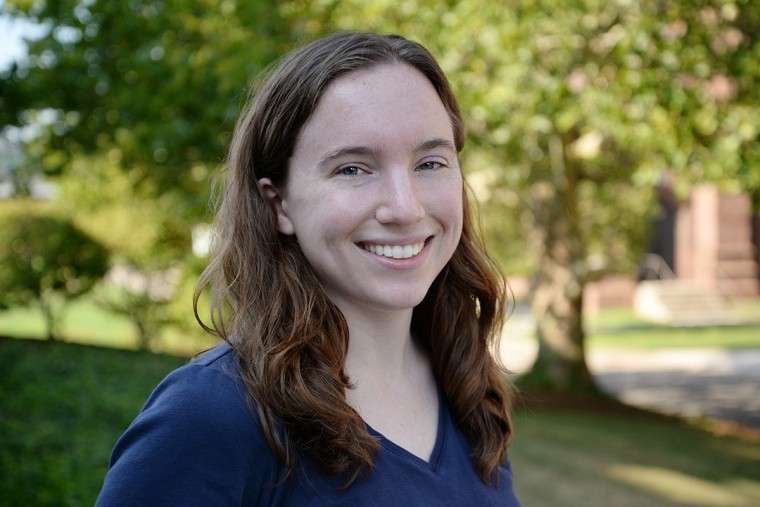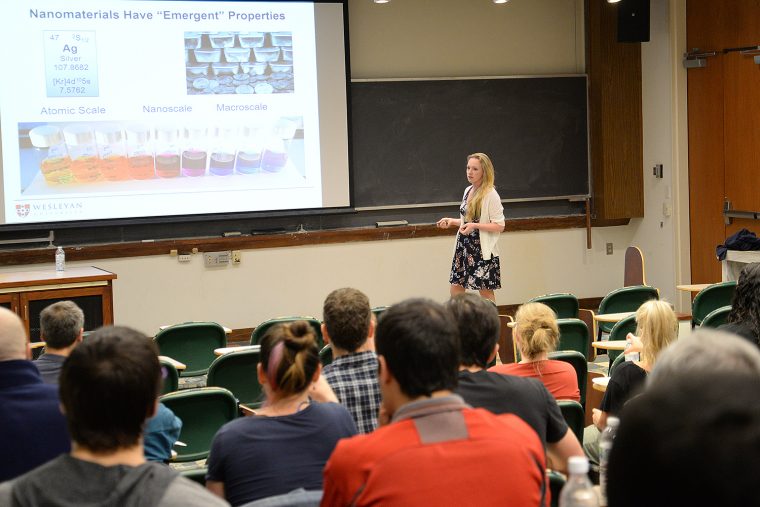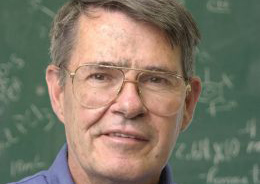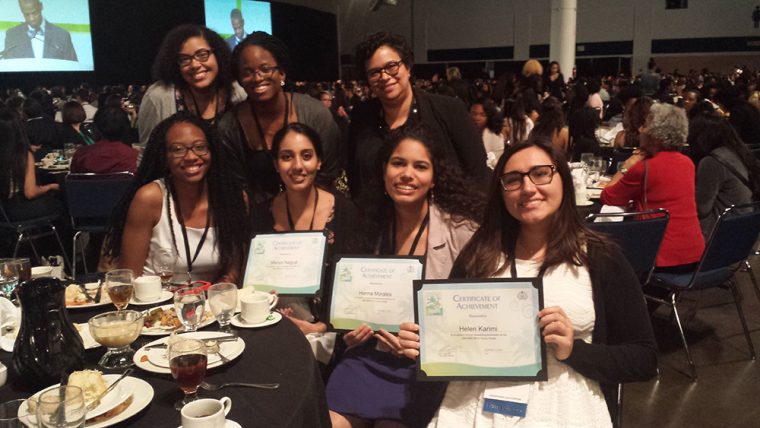This summer, Wesleyan hosted the second annual Wesleyan Scientific Imaging Contest, which recognizes student-submitted images from experiments or simulations done with a Wesleyan faculty member that are scientifically intriguing as well as aesthetically pleasing. This year, 33 images were submitted from six departments. The entries were judged based on the quality of the image and the explanation of the underlying science. The images were judged by a panel of four faculty members: Steven Devoto, professor of biology, professor of neuroscience and behavior; Ruth Johnson, assistant professor of biology, assistant professor of integrative sciences; Brian Northrop, assistant professor of chemistry, assistant professor of…
Michelle Personick, assistant professor of chemistry, and her graduate student Melissa King, are co-authors of a paper titled “Bimetallic Nanoparticles with Exotic Facet Structures via Iodide-Assisted Reduction of Palladium,” published in the journal Particle and Particle Systems Characterization, Vol. 34, Issue 5, in May 2017. The research was featured on the inside front cover of the issue. In this study, Personick and King explain how gold–palladium tetradecapods (14-pointed nanoparticles) with an unusual combination of both well-defined concave and convex facets can be synthesized by introducing dilute concentrations of iodide during nanoparticle growth. Iodide directs the formation of the tetradecapods by increasing…
All cells — bacterial or human — secrete up to 10 or 20 percent of the proteins that they make. Human secreted proteins, for example, include components of serum, hormones, growth factors that promote cell development during embryogenesis and tissue remodeling, and proteins that provide the basis for immune cell signaling during infection or when fighting cancer. The secretion process, however, isn't an easy feat for cells, as they need to move the proteins across a membrane through a channel. Transport requires the formation of a hairpin, formed by an initiator protein. In a recent study, Don Oliver, the Daniel Ayres Professor…
Michelle Personick, assistant professor of chemistry, received a two-year doctoral new investigator grant from the American Chemical Society Petroleum Research Fund (ACS PRF) to synthesize and test new metal nanomaterials designed to make industrial chemical processes more energy efficient. Her study, titled “Tailored Bimetallic Catalysts with Highly Stepped Facets for Selective and Energy-Efficient Epoxidation and Hydrogenation Reactions," will be supported for two years with a $110,000 award. "Global energy consumption is steadily increasing, and the chemical industry is the second largest consumer of delivered energy," Personick said. "The chemical industry is unique in that it uses energy resources, such as petroleum…
Five Wesleyan seniors were inducted into the American Society for Biochemistry and Molecular Biology honor society at the ASBMB annual meeting in Chicago, April 22-26. They are: Jennifer Cascino '17, Kaileen Fei '17, Julianne Riggs '17, Rachel Savage '17 and Stacy Uchendu '17. The ASBMB Honor Society recognizes exceptional undergraduate juniors and seniors who are pursuing a degree in the molecular life sciences for their scholarly achievement, research accomplishments, and outreach activities. The mission of the society is to advance the science of biochemistry and molecular biology through organization of scientific meetings, advocacy for funding of basic research and education, support…
Wesleyan co-authors published a paper titled “The Stories Tryptophans Tell: Exploring Protein Dynamics of Heptosyltransferase I from Escherichia coli” in the January 2017 issue of Biochemistry. The co-authors include chemistry graduate student Joy Cote; alumni Zarek Siegel ’16 and Daniel Czyzyk, PhD '15; and faculty Erika Taylor, associate professor of chemistry; Ishita Mukerji, the Fisk Professor of Natural Science, professor of molecular biology and biochemistry. Their paper investigates the intrinsic properties of Tryptophan amino acids found within the protein, Heptosyltransferase I, to understand the ways this protein moves during catalysis. Understanding the movement of this protein is an important step in developing…
Albert Fry, the E.B. Nye Professor of Chemistry, Emeritus, will be honored at the Electrochemical Society National Meeting in New Orleans in May. The symposium, aptly titled, “The 80th Birthday Trifecta in Organic Electrochemistry,” celebrates Fry, and his two colleagues, Professor Jean Lessard of Sherbrooke University and Professor Denis Peters of Indiana University, who will all be celebrating their 80th birthdays. “Besides having carried on research in organic electrochemistry for many years, each of us has served as chair of the organic and biological electrochemistry division of the Society, and Peters and I received the Baizer Award in organic electrochemistry,” explained…
From Nov. 9-12, two faculty members and five students from the physics and chemistry departments, attended the Annual Biomedical Research Conference for Minority Students in Tampa, Fla. Candice Etson, assistant professor of physics, and Erika Taylor, associate professor of chemistry, were joined by McNair Scholars Luz Mendez ’17, Tatianna Pryce ’17, Stacy Uchendu ’17 and Hanna Morales ’17; and Wesleyan Mathematics and Science (WesMaSS) Scholar Helen Karimi ’19. Students observed other research being performed around the nation by students who are members of underrepresented groups in Science, Technology, Engineering and Mathematics (STEM). In addition, the Wesleyan students presented their own research and Morales and Karimi…
Erika Taylor, associate professor of chemistry, is a co-author of a paper titled, “Methyl transfer by substrate signaling from a knotted protein fold,” published in the August 2016 issue of the Nature Structural & Molecular Biology newsletter. The paper describes the protein TrmD, an enzyme that catalyzes tRNA modification, but unlike most proteins, TrmD has an "interesting knotted configuration, which is not common," Taylor said. The paper demonstrates that even in proteins with knotted configurations, the internal protein movements and dynamics are important for binding, signaling and catalysis. "This is exciting because one might expect knotted proteins to be more static in…
The Molecular Biophysics Program, the Department of Chemistry and the Department of Molecular Biology and Biochemistry hosted the 17th Annual Molecular Biophysics and Biological Chemistry Retreat on Sept. 29 at Wadsworth Mansion in Middletown. The event included several talks by Wesleyan faculty and two student research poster presentations. Professor Anna Pyle delivered the keynote address titled "Structural and Mechanistic Insights into RNA Splicing." Pyle is the Howard Hughes Medical Institute Investigator and the William Edward Gilbert Professor in the Departments of Molecular, Cellular and Developmental Biology and Chemistry at Yale University. Pyle studies the structure and function of large RNA molecules…
Michelle Personick, assistant professor of chemistry, received the Victor K. LaMer Award from the American Chemical Society Division of Colloid and Surface Chemistry. The honor, which comes with a $3,000 monetary award, was presented at the ACS Colloid and Surface Science Symposium June 5-8 at Harvard University, where she presented a plenary talk. The Victor K. LaMer Award is presented to the author of an outstanding PhD thesis in colloid or surface chemistry. LaMer was the editor of the Journal of Colloid Science (now the Journal of Colloid and Interface Science) from its founding in 1946 to 1965. In addition to his seminal…









